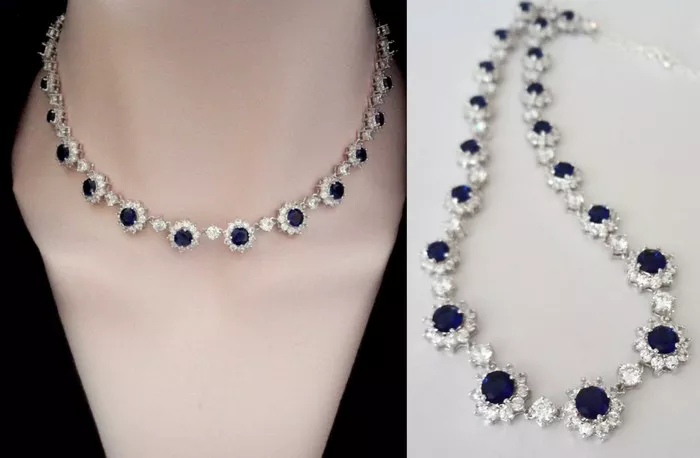Diamonds have long captivated human fascination with their dazzling brilliance and timeless allure. Adorning necklaces, these precious gemstones epitomize elegance, luxury, and status. Yet, behind their breathtaking beauty lies a complex tapestry of factors that contribute to their lofty price tags. From geological rarity to intricate craftsmanship, the value of diamond necklaces transcends mere aesthetics. Delving into the depths of this captivating world, we uncover the multifaceted reasons why diamond necklaces are so expensive.
Rarity and Value of Gem-Quality Diamonds
At the heart of the diamond’s allure lies its scarcity. While diamonds themselves aren’t exceedingly rare in nature, the quest for gem-quality specimens suitable for jewelry is a pursuit fraught with challenges. Geological conditions conducive to the formation of these flawless crystals are remarkably rare, and even when found, only a fraction meet the stringent criteria for gemstone quality. This inherent scarcity underpins the diamond’s intrinsic value, laying the groundwork for its exorbitant pricing.
The Four Cs: Cornerstones of Diamond Valuation
Central to understanding the pricing of diamond necklaces are the Four Cs: cut, clarity, color, and carat weight. These criteria serve as the benchmarks by which diamonds are graded and valued. The precision of the cut determines the stone’s brilliance and fire, while clarity refers to the absence of internal flaws or blemishes. Color, or lack thereof, significantly impacts a diamond’s allure, with colorless stones commanding a premium. Finally, carat weight serves as a measure of a diamond’s size, with larger stones often fetching higher prices. The interplay of these factors intricately shapes the value proposition of each diamond necklace, reflecting the expertise required to source and curate stones of exceptional quality.
Mining and Production Costs: Unearthing the True Price of Diamonds
Beneath the earth’s surface, the journey of a diamond begins with the arduous process of mining. From open-pit operations to underground excavations, diamond mining is a resource-intensive endeavor fraught with logistical challenges. Heavy machinery, skilled labor, and stringent environmental regulations converge to inflate production costs, amplifying the price tag of each carat extracted. Moreover, ethical mining practices further compound these expenses, as stakeholders prioritize sustainability and social responsibility in an increasingly conscientious market landscape.
Marketing and Perceived Value: The Romance of Diamonds
Fueling the allure of diamond necklaces is the power of marketing, epitomized by iconic campaigns spearheaded by industry giants like De Beers. Through strategic storytelling and targeted messaging, diamonds have been indelibly associated with romance, love, and eternal commitment. These carefully crafted narratives evoke a sense of aspiration and desirability, transcending the mere materiality of the stones themselves. As a result, consumer demand is not merely driven by intrinsic value but is heavily influenced by emotional resonance and societal perceptions of luxury.
Supply and Demand Dynamics: Balancing Act in the Diamond Market
In the realm of diamond economics, the delicate equilibrium of supply and demand dictates pricing dynamics. Fluctuations in global economic conditions, shifting consumer preferences, and geopolitical factors all play a pivotal role in shaping market forces. The controlled release of diamond inventories by major producers further influences price stability, as strategic stockpiling mitigates the volatility inherent in a finite resource market. Consequently, the interplay of supply constraints and evolving consumer demand patterns serves as a fulcrum upon which diamond prices teeter.
Cutting and Polishing Process: The Artistry of Craftsmanship
Beyond their raw form, diamonds undergo a metamorphic transformation through the hands of skilled artisans. The cutting and polishing process, characterized by meticulous precision and unwavering attention to detail, imbues each stone with its signature brilliance and allure. From traditional techniques passed down through generations to state-of-the-art technologies that push the boundaries of perfection, the craftsmanship involved in shaping diamonds is a testament to human ingenuity. However, this labor-intensive process exacts a toll on both time and resources, amplifying the final cost of diamond jewelry.
Historical Context: A Tapestry Woven with Prestige
To truly appreciate the value of diamond necklaces, one must journey through the annals of history, where these precious gemstones have held sway over empires and civilizations alike. From ancient monarchs who revered them as talismans of power to modern-day icons who flaunt them as symbols of status, diamonds have transcended temporal boundaries to become enduring emblems of prestige. The evolution of diamond pricing mirrors the ebb and flow of societal values, reflecting the interplay of tradition, innovation, and the inexorable march of time.
In conclusion, the exorbitant price of diamond necklaces is not merely a reflection of their intrinsic rarity or aesthetic appeal but a testament to the intricate web of factors that converge to elevate them to iconic status. From the depths of the earth to the heights of human imagination, diamonds embody the pinnacle of luxury, commanding prices commensurate with their timeless allure. As we peer through the facets of these mesmerizing gemstones, we glimpse a world where beauty, craftsmanship, and legacy intertwine to create treasures of unparalleled value.

